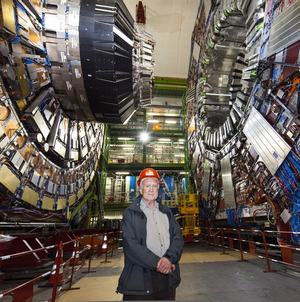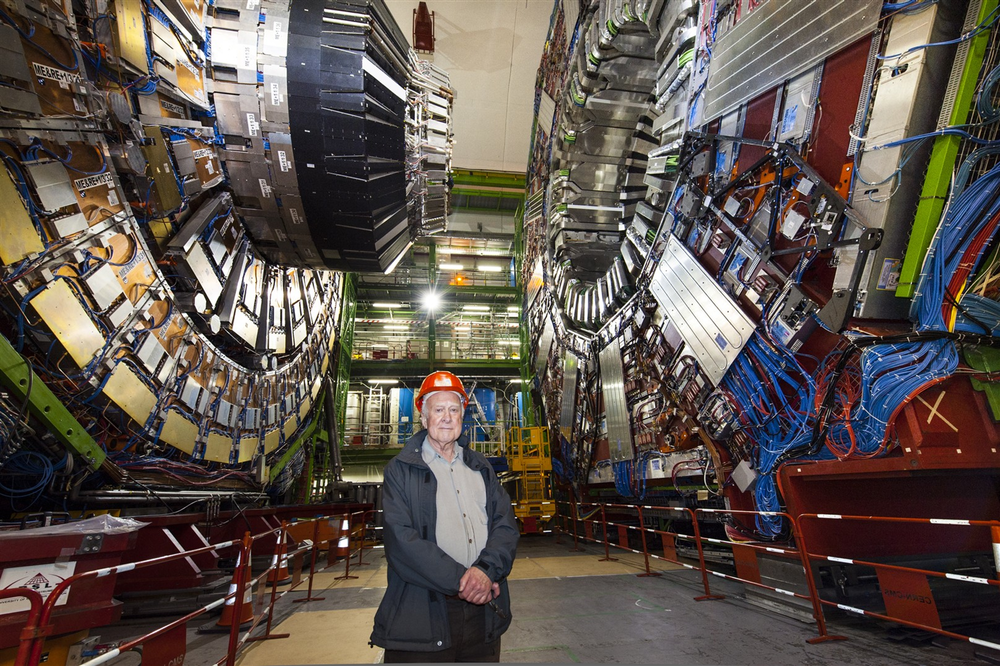Nobel Prize—Why Particles Have Mass
Nearly 50 years after its prediction, particle physicists have finally captured the Higgs boson. So the Nobel Committee has awarded this year’s physics prize to two of the theorists who initiated this particle hunt. François Englert of the Free University of Brussels (ULB) and Peter Higgs of the University of Edinburgh, UK, independently derived a model explaining why particles are not massless, and this model requires the existence of the Higgs boson. Both papers were published in 1964 in Physical Review Letters.
The Higgs boson is the final piece of the standard model of particle physics to be observed, following decades of searching. In June 2012, CERN announced with much fanfare that the Large Hadron Collider (LHC) in Geneva had discovered a particle with the right properties to be the Higgs boson, which signified that researchers had confirmed a fundamental theory of mass.
The Higgs boson does not technically give other particles mass. More precisely, the particle is a quantized manifestation of a field (the Higgs field) that generates mass through its interaction with other particles. But why couldn’t mass just be assumed as a given?
The answer goes back to previous work in quantum field theory. Quantum fields are similar to more familiar fields, like electric and magnetic fields. But quantum fields contain excited states that we observe as particles. These fields can be divided into matter fields (whose particles are electrons, quarks, etc.) and force fields (whose particles are photons, gluons, etc.). In the late 1940s, theorists showed that a quantum field theory of photons and electrons could successfully explain electromagnetic interactions at high energy.
However, the theory had trouble modeling nuclear interactions. The short range of the weak nuclear force implied that its corresponding particles had mass, in contrast with the massless photon, the particle associated with electromagnetic fields. Simply sticking a mass onto a force-carrying particle had disastrous effects, causing certain predictions to diverge to infinity. In the early 1960s, theorists were busy looking for alternative ways that mass might be introduced into the theory.
The solution formulated by Higgs, Englert, and Robert Brout (who worked with Englert at ULB but is now deceased) proposes that all of space is filled with a field that interacts with the weak force particles to give them mass. It does so because the field is assumed not to be zero in empty space. This nonzero ground state violates a symmetry that is considered fundamental to quantum field theory. Earlier work had shown that this kind of symmetry breaking led to a massless, spinless particle that was ruled out by experiments [1]. Englert, Brout, and Higgs showed how one could make this unwanted particle disappear by coupling the space-filling field to the weak-force field. When they worked out all of the interactions, they found that the force particles effectively had a mass, and the unwanted, massless, spinless particle was essentially absorbed by the weak particles. These particles gained a third spin state as a result, and the only remaining spinless particle was the massive Higgs boson. A similar theory was developed by a third team of theorists in the same year [2].
Subsequent work showed that the Brout-Englert-Higgs mechanism (or “Higgs mechanism,” for short) could give mass not only to weak particles, but also to electrons, quarks, and other fundamental particles. The more strongly a particle interacts with the Higgs field, the more massive it is. It’s important to note, however, that most of the mass in composite particles, like protons, nuclei, and atoms, does not come from the Higgs mechanism, but from the binding energy that holds these particles together.
“Brout and Englert and Higgs put forth a very clever idea, now known as the Higgs mechanism,” says Michael Turner of the University of Chicago. “It provides an explanation for one of the simplest questions one can ask: why do particles have mass? Such a simple question—but very profound—that many don’t even think to ask it.” To validate this mechanism, particle physicists constructed the LHC, the largest, most technologically sophisticated machine ever built, says Joseph Incandela, spokesperson for the CMS experiment, which was one of the detectors that spotted the Higgs boson. “I think people look at this and feel that particle physics has pulled off something like a moon landing here,” he says.
–Michael Schirber
Michael Schirber is a Corresponding Editor for Physics Magazine based in Lyon, France.
References
- J. Goldstone, “Field theories with Superconductor Solutions,” Nuovo Cimento 19, 154 (1961); J. Goldstone, A. Salam, and S. Weinberg, “Broken Symmetries,” Phys. Rev. 127, 965 (1962)
- G. S. Guralnik, C. R. Hagen, and T. W. B. Kibble, “Global Conservation Laws and Massless Particles,” Phys. Rev. Lett. 13, 585 (1964)





